Post Underwater Wet Welding Heat Treatment by Underwater Wet Induction Heating
IF 1.4
3区 材料科学
Q2 METALLURGY & METALLURGICAL ENGINEERING
引用次数: 4
Abstract
Wet welding procedures of Class A structural ship steels frequently fail to comply with the American Welding Society (AWS) D3.6M, Underwater Welding Code, in the maximum hardness criterion for the heat-affected zone (HAZ). The maximum hardness accepted in a welded joint is 325 HV for higher-strength steel (yield strength > 350 MPa). In multi-pass welds, this problem occurs frequently and is restricted to the HAZ of the capping passes. The HAZ of the root and filling passes are softened by the reheating promoted by their respective subsequent passes. This paper presents the results of exploratory research into postweld underwater electromagnetic induction heating. The objective of the research was to evaluate the ability of induction heating to soften the specific high-hardness HAZs in underwater conditions. The results showed that this technique could reduce the maximum HAZ hardness of low-carbon structural ship steel welds to values below 325 HV, which is the maximum accepted by AWS for Class A welds. The induction-heated zone reached a maximum depth of about 10 mm, which is considered adequate to treat the HAZ of cap-ping passes in underwater wet welds.水下湿感应加热水下湿焊后热处理
船舶A类结构钢的湿焊工艺常常不符合美国焊接协会(AWS) D3.6M《水下焊接规范》中热影响区(HAZ)最大硬度标准的要求。高强度钢(屈服强度> ~ 350mpa)焊接接头可接受的最大硬度为325 HV。在多道次焊接中,这个问题经常发生,并且仅限于封盖道的热影响区。根道段和充填道段的热影响区通过各自后续道段的再加热得到软化。本文介绍了焊后水下电磁感应加热的探索性研究成果。本研究的目的是评估感应加热在水下条件下软化特定高硬度haz的能力。结果表明,该工艺可将低碳结构钢焊缝的最大HAZ硬度降低到325 HV以下,这是美国焊接学会(AWS)对A类焊缝可接受的最大HAZ硬度。感应加热区最大深度约为10 mm,足以处理水下湿焊中盖口的热影响区。
本文章由计算机程序翻译,如有差异,请以英文原文为准。
求助全文
约1分钟内获得全文
求助全文
来源期刊

Welding Journal
工程技术-冶金工程
CiteScore
3.00
自引率
0.00%
发文量
23
审稿时长
3 months
期刊介绍:
The Welding Journal has been published continually since 1922 — an unmatched link to all issues and advancements concerning metal fabrication and construction.
Each month the Welding Journal delivers news of the welding and metal fabricating industry. Stay informed on the latest products, trends, technology and events via in-depth articles, full-color photos and illustrations, and timely, cost-saving advice. Also featured are articles and supplements on related activities, such as testing and inspection, maintenance and repair, design, training, personal safety, and brazing and soldering.
 求助内容:
求助内容: 应助结果提醒方式:
应助结果提醒方式:


